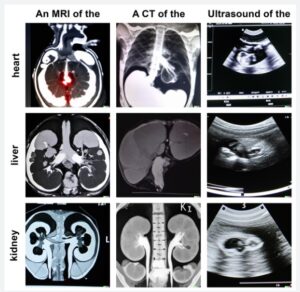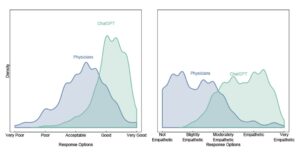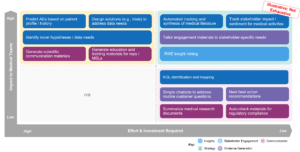Posted by By Mary Lee, Ph.D., Harrison Liu, Ph.D., and Rachana Gollapudi on July 17th, 2023.
Artificial intelligence (AI) has recently sparked the public’s imagination and become a prominent topic of discussion, propelled by the release of OpenAI’s ChatGPT and other widely available chatbots. For some, the impressive capabilities of AI represent a groundbreaking advancement with the potential to drive remarkable efficiency and productivity gains. Others express concerns about the potential impact of AI on employment, or in facilitating the spread of misinformation. It is not hard to imagine that the true impact of AI will include a combination of positives and negatives.
A specific area in which AI could have a very significant impact is healthcare. In this brief overview, we define AI and explore its potential impact in a broad sense. Then, we narrow our focus and discuss how it might affect Medical Affairs more specifically. Finally, we outline what Medical Affairs teams can start doing now to proactively leverage AI to improve service to their stakeholders.
What is Artificial Intelligence?
Artificial intelligence refers to the development of computer systems and algorithms that are capable of performing tasks that typically require human intelligence, such as learning, problem-solving, perception, and decision-making. Broadly speaking, AI algorithms can be described as discriminative or generative.
Discriminative AI is used to classify or segment data into relevant categories. Image classification algorithms for autonomous vehicles represent a classic example of discriminative AI. These algorithms rapidly analyze camera images to identify the other cars, pedestrians, motorcycles, stoplights, road signs, and the roadside to help autonomous vehicles safely navigate a complex environment.
Generative AI, in contrast, can create novel, original outputs similar to the data they were trained on. Examples include chatbots, such asChatGPT, which can answer questions, draft essays, and so on. Other examples include Midjourney, which can generate art based upon user prompts. We are still beginning to understand the full potential of generative AI and there is no doubt that new applications will continue to proliferate as it becomes increasinglyI embedded into daily life.
Examples of Artificial Intelligence in Healthcare
As the field of AI in healthcare continues to evolve and mature, we may see a surge in applications that harness the full potential of this transformative technology. Below, we share a few illustrative examples to provide a glimpse into how AI is being leveraged today.
Avenda Health Software’s Unfold AI
Unfold AI , developed by Avenda Health, is a good example of discriminative AI in healthcare. This tool aims to enhance prostate cancer prognoses. When oncologists treat prostate cancer, they commonly rely on magnetic resonance imaging (MRI) scans to assess the size and spread of tumors in the prostate. Nevertheless, MRI scans can occasionally fail to detect small tumors or underestimate their actual size.
, developed by Avenda Health, is a good example of discriminative AI in healthcare. This tool aims to enhance prostate cancer prognoses. When oncologists treat prostate cancer, they commonly rely on magnetic resonance imaging (MRI) scans to assess the size and spread of tumors in the prostate. Nevertheless, MRI scans can occasionally fail to detect small tumors or underestimate their actual size.
Unfold AI is designed to help provide physicians with a clearer understanding of the true tumor extent for a patient. It combines patient-specific data with deep-learning algorithms to create a tailored cancer probability map. It also provides a three-dimensional visual representation of the likely tumor to help oncologists more effectively plan interventions.
Unfold AI received FDA 510(k) clearance in December of 2022 and has begun to be integrated into some practices today.
Image Modeling with DALL-E 2
 Generative AI tools, such as DALL-E 2, have the ability to create simulated medical images, mimicking a range of modalities including MRI, X-ray, ultrasound, and computed tomography (CT) scans. These images, in turn, can serve as valuable training tools.
Generative AI tools, such as DALL-E 2, have the ability to create simulated medical images, mimicking a range of modalities including MRI, X-ray, ultrasound, and computed tomography (CT) scans. These images, in turn, can serve as valuable training tools.
To be truly useful in this regard, some fine-tuning of the images will be required, at least for now. As this technology develops and generative AI tools are better “trained” on real images, the raw outputs will likely become increasingly realistic.
One word of caution, though: the ability to generate highly authentic-seeming yet counterfeit medical images could potentially facilitate medical fraud. Increased diligence and proactive mitigations will likely be needed to address this emerging challenge.
Answering Patient Questions with Generative AI
A recent study, published in JAMA Internal Medicine in April of 2023, indicates that generative AI may be a useful tool for formulating answers to patients’ questions. During the study, independent licensed healthcare professionals evaluated all answers for quality and empathy. Results showed that ChatGPT out-performed human physicians on both metrics, especially empathy. Overall, the evaluators preferred ChatGPT’s responses 79% of the time.
Figure 3- Chart from a study in JAMA Internal Medicine evaluating physician’s responses to patients’ questions vs. ChatGPT’s responses. Quality is on the left, empathy on the right.
It is important to note that no one is proposing that generative AI replace human physicians. However, it does suggest that AI can be a powerful tool to help healthcare providers communicate with patients, potentially improving their ability to provide accurate and empathetic responses.
Potential Impacts in the Broader Healthcare Space
AI brings a broad and diverse base of capabilities to the healthcare space, limited only by the creativity and ingenuity of its users. While it is impossible to predict with certainty how AI it will affect healthcare, we can highlight three general areas that are likely to see changes:
- How patients interact with the healthcare system – AI will likely be used to automate or streamline many patient logistics such as appointment scheduling, delivering relevant educational content, or assisting patients in adhering to their medications.
- How physicians practice medicine – The demands upon physician time steadily increases each year, and there are ongoing efforts to automate portions of routine tasks (e.g., note writing) to AI, allowing physicians to focus on higher-value tasks (e.g., patient interaction). In addition, AI has the potential to act as a “thought partner” to physicians by providing clinical decision support and suggestions on personalized treatment plans based on patient characteristics.
- How the biopharma industry innovates and delivers medicines – AI has begun to make inroads in helping drug discovery teams identify new therapeutic targets, design new compounds, and/or optimize leads. Drug developers are also leveraging AI to identify trial sites or patients to streamline and accelerate clinical development.
Table 1 provides a more detailed list of potential impacts.
Table 1: Potential Ways AI Can Transform the Healthcare System
| How Patients Interact with the Healthcare System | How Physicians Practice Medicine | How the Biopharma Industry Innovates & Delivers Medicines |
|---|---|---|
| Patient Communication: Streamline communications within the healthcare system (e.g., appointment scheduling, medication reminders) Patient Education: Create educational content that is tailored to specific needs & preferences (e.g., summarize latest medical research in layman’s terms) Patient Empowerment: Provide patients with access to their health data | Task Automation: Automate routine tasks (such as note-taking) to allow the physician to focus on higher-value interactions with patients. Diagnosis: Analyze patient data and medical imaging to support diagnoses Personalized Medicine: Suggest personalized patient treatment recommendations Predictive Analytics: Identify patterns & risk factors for disease Clinical Decision Support: Provide real-time support (e.g., AE monitoring, predictive outcomes) Medical Research: Analyze and provide summaries of trial results & medical journals to healthcare providers | Drug Discovery / Development: Identify therapeutic targets, design new drugs, optimize lead compounds, & predict efficacy / safety of drug candidates Clinical Trials: Optimize trial design by identifying patient populations, trial sites, & optimize treatment protocols Supply Chain: Predict demand for drugs & optimize manufacturing & distribution networks Regulatory Compliance: Analyze company materials for regulatory requirements to maintain compliance Commercial Optimization: Analyze larger and more nuanced datasets to better target and optimize commercial efforts |
Potential Uses of AI in Medical Affairs
In our ebook, Medical Affairs Metamorphosis, we have outlined five different areas of responsibility for Medical Affairs (MA) teams. AI has the potential to support MA’s efforts in each of those areas:
- Insight Generation – AI tools could be used to analyze a broad array of data sources to identify insights that could be useful to MA’s mission.
- Strategy Development – Once useful insights have been derived, the MA team must determine what to do with them and how to leverage them for strategy development. Here, AI could strengthen the strategic direction of MA teams by identifying and suggesting best practices and analogs.
- Evidence Generation – MA is increasingly becoming a hub for evidence generation within biopharma companies. AI could help innovate evidence generation by generating hypotheses and study designs.
- Stakeholder Engagement – AI tools could help optimize engagement planning (i.e., who to talk to, when) and suggest next best actions for engaging with physicians, patient advocacy groups, patients, and other stakeholders.
- Communication – MA teams might also be able to leverage AI tools to enable real-time tailoring of communications to key stakeholders.
MA teams are beginning the process of exploring how AI could support their missions. While some uses will be high-impact for the organization, others may require more investment and effort to meaningfully apply. Figure 4 provides a summary of potential uses, mapped according to their likely impact vs. the effort required to put them into action.
Figure 4 – Potential Uses of AI in Medical Affairs, Impact vs. Effort Required
Ferma.AI: An Example of AI Use in Medical Affairs
Ferma.AI offers an example of a life-science-focused AI application being developed to support medical conference attendance and competitive intelligence. This has the potential to support the “Insight Generation” area of responsibility for Medical Affairs listed above.
Developed by ZoomRx, Ferma.AI is a large language model that is trained on life sciences data sets, literature, and terminology. The final vision for Ferma.AI is to be able to provide clinically and scientifically-relevant responses to user queries grounded in the medical literature.
An early proposed use case for the technology is to utilize Ferma.AI to virtually “attend” a medical conference, “read” through the posters, abstracts, presentations, transcripts, social media posts, etc. and then summarize and compare data presented at the conference or gauge the excitement around a new data release. These capabilities could also be leveraged for regular monitoring of the competitive landscape and/or developments in the literature.
Potential Risks of AI in Medical Affairs
As promising as AI is for Medical Affairs, there is also a range of potential risks for teams to keep in mind. Table 2 provides a summary.
Table 2 – Potential Risks
| Misleading Information | Many AI systems are a “black box” and can unintentionally produce misleading or incorrect information, which may result in direct harm to patients or healthcare systems. |
| Privacy & Data Breach Risks | Without proper regulatory safeguards, AI poses a risk to data privacy. Additionally, AI may be able to predict private information about patients. |
| Data Bias & Inequality | AI systems learn from the data on which they are trained, and they can reinforce underlying biases and inequalities in healthcare systems. |
| Data Fragmentation | AI systems require large volumes of data for training purposes, which are typically fragmented across several systems and difficult (and expensive) to consolidate. |
| Feasibility Concerns | The margin of error within healthcare is slim as mistakes directly impact human health and happiness - raising the bar especially high for AI, which is still a nascent technology. |
IBM Watson serves as a cautionary tale in the application of AI in healthcare. After gaining fame by winning Jeopardy! in 2011, Watson shifted its focus to healthcare. In 2012, IBM partnered with Memorial Sloan Kettering to train Watson to provide real-time cancer treatment recommendations. However, the project encountered major problems, such as spending over $5 billion on training data and offering recommendations that were either obvious or inconsistent with established treatment guidelines. The partnership ended in 2015, and by 2022, Watson was effectively shut down and sold to a private equity firm.
Where Does Medical Affairs Go from Here?
Artificial intelligence has the potential to revolutionize healthcare, including Medical Affairs. However, its implementation in the healthcare space is still in its early stages, and many uncertainties remain. It is difficult to predict which AI tools and applications will become the new standard and which will fade away as their usefulness fails to materialize. Given the uncertain landscape, Medical Affairs teams may find it challenging to determine the best course of action.
In such circumstances, it is advisable to approach AI exploration cautiously as opposed to diving in headfirst, especially given the high clinical and scientific standards to which Medical Affairs professionals strive to hold themselves. Going forward, Medical Affairs teams should consider the following three points:
- As patients and other stakeholders start using AI tools for their own healthcare education, Medical Affairs should be prepared to identify and respond to potential misperceptions.
- Leverage AI to find low-risk, smarter ways of working within Medical Affairs, especially given the sensitivities around the clinical and scientific nature of the work.
- Begin discussions with internal partners (e.g., commercial and other cross-functional stakeholders) to better understand how future AI approaches fit into the overall corporate strategy and vision.
By taking these steps now, Medical Affairs teams can initiate a vital cross-functional dialogue and establish themselves as crucial contributors in helping the broader enterprise determine how best to leverage this promising new technology.




































